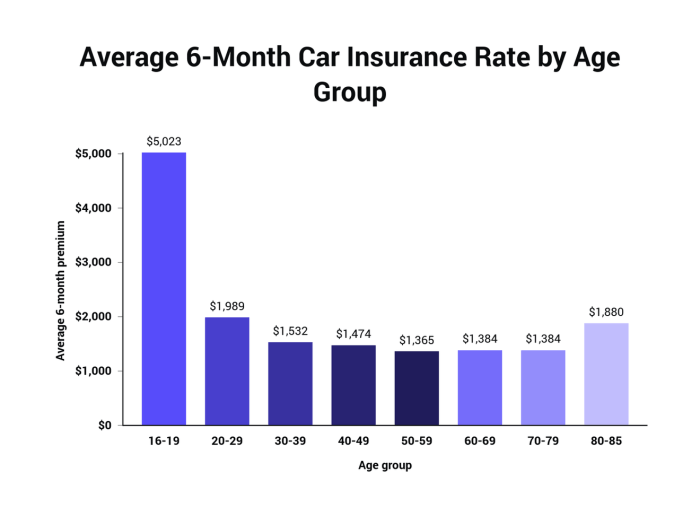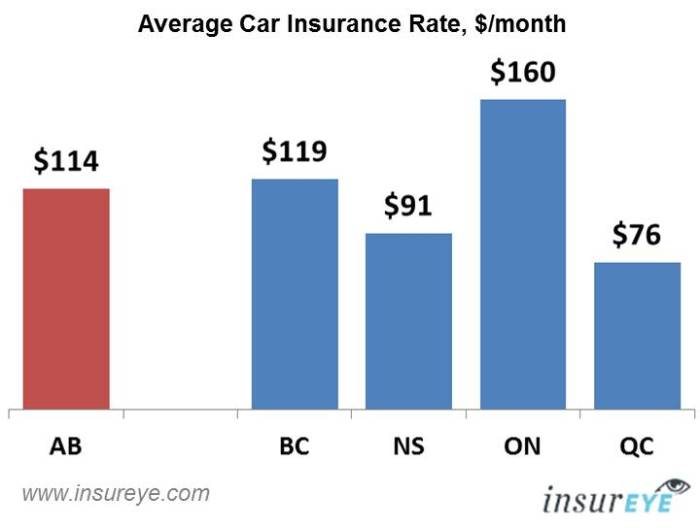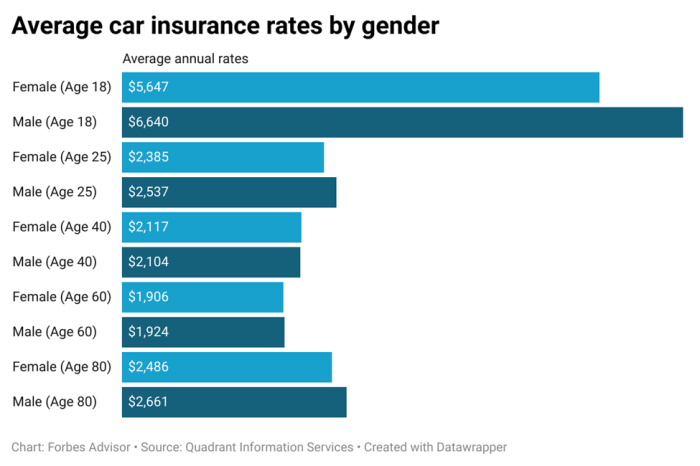Navigating the world of car insurance can feel like driving through a maze. Understanding the factors that influence your monthly premiums is crucial to securing affordable and adequate coverage. This guide delves into the complexities of car insurance pricing, providing insights into how various elements—from your age and driving history to your vehicle type and location—impact your monthly costs. We’ll equip you with the knowledge and strategies to find the best rates and save money.
From comparing quotes and understanding coverage options to exploring discounts and saving strategies, we’ll cover all the essential aspects of managing your car insurance budget effectively. We aim to demystify the process, empowering you to make informed decisions and secure the best possible car insurance protection without breaking the bank.
Factors Influencing Monthly Car Insurance Costs
Several key factors interact to determine your monthly car insurance premium. Understanding these elements can help you make informed decisions and potentially save money. This section will explore the major influences on your insurance costs.
Age and Driving History
Your age significantly impacts your insurance rates. Younger drivers, particularly those under 25, generally pay higher premiums due to statistically higher accident rates. Insurance companies perceive them as higher risk. Conversely, drivers in their mid-30s to mid-50s often enjoy lower rates because they represent a lower-risk demographic. Your driving history is equally crucial. A clean driving record with no accidents or traffic violations will earn you lower premiums, while accidents, speeding tickets, or DUI convictions will substantially increase your costs. The severity and frequency of incidents are considered. For example, a single minor fender bender will impact your premiums less than a serious accident resulting in injuries or significant property damage.
Vehicle Type and Features
The type of vehicle you drive plays a considerable role in your insurance cost. Sports cars, luxury vehicles, and high-performance models generally command higher premiums due to their higher repair costs and increased risk of theft. Conversely, smaller, less expensive vehicles typically attract lower premiums. Vehicle features also matter. Safety features like anti-lock brakes, airbags, and electronic stability control can lead to lower premiums, as these features reduce the likelihood and severity of accidents. Conversely, features that increase the cost of repairs, such as advanced technology or specialized parts, can increase your insurance premiums.
Location
Your location significantly influences your insurance rates. Areas with high crime rates, frequent accidents, or severe weather conditions will typically result in higher premiums due to the increased risk for insurers. Urban areas often have higher rates than rural areas. This is because factors such as traffic congestion, theft, and vandalism are more prevalent in densely populated areas. Insurance companies carefully analyze claims data for specific zip codes to assess risk levels and set premiums accordingly. For example, someone living in a high-crime city center will likely pay more than someone in a quiet suburban neighborhood.
Coverage Levels
Different coverage levels translate to varying premiums. Liability coverage, which protects you financially if you cause an accident, is usually mandatory. However, the amount of liability coverage you choose directly impacts your cost. Higher liability limits mean higher premiums. Collision coverage pays for repairs to your vehicle regardless of fault, while comprehensive coverage protects against damage from non-collision events such as theft, vandalism, or weather damage. Both collision and comprehensive are optional but significantly increase your premium compared to liability-only coverage. Adding these coverages provides more financial protection but comes at a higher cost.
Relative Impact of Factors on Monthly Premiums
| Factor | Low Impact | Medium Impact | High Impact |
|---|---|---|---|
| Age | 30-50 | 25-29, 51-65 | Under 25, Over 65 |
| Driving History | Clean record | Minor accidents/tickets | Serious accidents/DUIs |
| Vehicle Type | Small, economical car | Mid-size sedan | Sports car, luxury vehicle |
| Location | Rural area, low crime | Suburban area | Urban area, high crime |
Finding the Best Monthly Car Insurance Rates

Securing the most affordable car insurance requires a proactive approach. By understanding how insurers assess risk and employing effective comparison strategies, you can significantly reduce your monthly premiums. This section Artikels practical steps to navigate the car insurance market and find the best rates for your needs.
Comparing Insurance Quotes
Effectively comparing quotes necessitates a systematic approach. Don’t simply settle for the first quote you receive. Instead, obtain quotes from multiple insurers, ensuring you provide consistent information across all applications to maintain a fair comparison. Consider using online comparison websites, which allow you to input your details once and receive multiple quotes simultaneously. However, remember that these websites may not include every insurer, so it’s beneficial to also contact insurers directly. Pay close attention to the policy details, coverage limits, and deductibles, as these factors can significantly influence the overall cost. Comparing apples to apples is crucial for accurate assessment.
Bundling Insurance Policies
Bundling your car insurance with other types of insurance, such as homeowners or renters insurance, often results in significant savings. Insurers frequently offer discounts for bundling policies, as it simplifies their administration and reduces their risk. However, the extent of the discount varies depending on the insurer and the specific policies bundled. It’s important to compare the bundled price with the individual policy prices to ensure that the discount is genuinely beneficial. For instance, while bundling home and auto insurance might offer a 15% discount, it’s crucial to verify that this discount leads to a lower overall cost than purchasing the policies separately. A drawback is that you are locked into a specific insurer for multiple policies, limiting your flexibility should you need to switch providers later.
Impact of Discounts on Premiums
Several discounts can significantly lower your monthly premiums. Safe driver discounts reward individuals with clean driving records, often providing substantial savings. Good student discounts are frequently available to students maintaining a certain GPA, reflecting the reduced risk associated with responsible academic performance. Other common discounts include those for anti-theft devices, multiple car policies, and completing defensive driving courses. These discounts are not universal; their availability and the discount percentage offered vary among insurers. For example, a safe driver discount might range from 10% to 25% depending on your driving history and the insurer. Actively pursuing and qualifying for these discounts can lead to considerable savings over time.
Improving Your Driving Record
Maintaining a clean driving record is perhaps the most impactful way to lower your insurance costs. Avoid traffic violations, accidents, and speeding tickets. Any incident on your record can lead to increased premiums for several years. Consider defensive driving courses, which can not only improve your driving skills but also potentially qualify you for discounts. If you have past infractions, focus on maintaining a spotless driving record going forward to see premiums gradually decrease over time. For instance, a single speeding ticket might increase your premiums by 20-30% for a year or more, depending on the severity and your insurer’s policy.
Obtaining Car Insurance Quotes Online
A step-by-step guide to obtaining online car insurance quotes involves:
- Visit multiple insurance company websites or comparison websites.
- Provide accurate information about your vehicle, driving history, and personal details.
- Carefully review the coverage options and select the level of coverage that meets your needs.
- Compare quotes from different insurers, focusing on the overall cost, coverage details, and customer reviews.
- Choose the policy that best balances cost and coverage, and complete the online application process.
- Review the policy documents carefully before finalizing the purchase.
Remember that providing accurate information is crucial for obtaining an accurate quote. Inaccurate or incomplete information can lead to incorrect pricing and potential problems later.
Understanding Your Car Insurance Policy

Choosing the right car insurance policy can feel overwhelming, but understanding the different types of coverage and what’s included is crucial for protecting yourself financially. This section clarifies the key components of a typical car insurance policy, empowering you to make informed decisions.
Types of Car Insurance Coverage
Car insurance policies typically offer several types of coverage, each designed to protect you in different scenarios. Liability coverage pays for damages or injuries you cause to others. Collision coverage pays for damage to your car regardless of fault. Comprehensive coverage protects against non-collision damage, such as theft or weather-related events. Uninsured/underinsured motorist coverage protects you if you’re hit by a driver without insurance or with insufficient coverage. Medical payments coverage helps pay for medical bills resulting from a car accident, regardless of fault. Personal injury protection (PIP) covers medical expenses and lost wages for you and your passengers, regardless of fault.
Coverage Under a Typical Policy
A standard car insurance policy usually includes liability coverage, which is often mandated by law. This covers bodily injury and property damage caused to others in an accident you’re at fault for. Collision coverage will typically cover repairs or replacement of your vehicle if it’s damaged in an accident, regardless of who’s at fault. Comprehensive coverage extends beyond accidents, protecting your vehicle from events such as theft, vandalism, fire, and hail damage. Many policies also include uninsured/underinsured motorist coverage, offering protection if you’re involved in an accident with a driver who lacks sufficient insurance. Medical payments coverage provides funds for medical bills incurred by you or your passengers, regardless of fault. Finally, personal injury protection (PIP) offers broader coverage, including medical expenses, lost wages, and even death benefits.
Examples of Insurance Coverage Application
Consider these scenarios: If you rear-end another car, causing damage and injury, your liability coverage would help pay for the other driver’s medical bills and vehicle repairs. If a tree falls on your car during a storm, your comprehensive coverage would cover the damage. If you’re involved in an accident with an uninsured driver who causes significant damage, your uninsured/underinsured motorist coverage steps in. If you’re injured in an accident, your medical payments coverage or PIP would help cover your medical expenses.
Key Terms and Conditions of a Standard Car Insurance Policy
Understanding your policy’s terms is vital. Below is a list of key elements commonly found in standard policies:
- Policy Period: The duration of your insurance coverage.
- Premium: The amount you pay for your insurance coverage.
- Deductible: The amount you pay out-of-pocket before your insurance coverage begins.
- Coverage Limits: The maximum amount your insurance company will pay for a covered claim.
- Exclusions: Specific events or circumstances not covered by your policy.
- Named Insured: The person(s) listed on the insurance policy.
- Covered Vehicles: The vehicles specifically covered under the policy.
- Duties After an Accident: Steps you must take following an accident, such as notifying the police and your insurance company.
Understanding these terms helps you know what to expect from your insurance company in the event of a claim.
Understanding Your Policy’s Deductible and Premium
Your premium is the regular payment you make to maintain your insurance coverage, while the deductible is the amount you pay out-of-pocket before your insurance coverage kicks in. For example, a $500 deductible means you pay the first $500 of repair costs after an accident, and your insurance covers the rest. Higher deductibles generally lead to lower premiums, and vice versa. Choosing the right balance between deductible and premium depends on your risk tolerance and financial situation. A higher deductible means lower monthly payments but a larger upfront cost if you have an accident. A lower deductible means higher monthly payments but lower out-of-pocket expenses in case of an accident. For instance, a policy with a $1000 deductible might have a lower monthly premium compared to a policy with a $500 deductible.
Epilogue

Securing affordable car insurance requires careful planning and informed decision-making. By understanding the factors that influence monthly premiums, actively comparing quotes, and leveraging available discounts, you can significantly reduce your insurance costs. Remember, proactive management of your driving record and insurance policy can lead to long-term savings and peace of mind. Take control of your car insurance budget today and drive confidently knowing you have the right coverage at the right price.
FAQs
What is the average monthly car insurance cost?
The average monthly cost varies significantly based on numerous factors, including location, age, driving history, and the type of vehicle. There’s no single “average” figure.
Can I pay my car insurance annually instead of monthly?
Many insurers offer the option of annual payments, often with a slight discount compared to monthly installments.
How often are car insurance rates reviewed?
The frequency of rate reviews varies by insurer, but many review rates annually or at policy renewal.
What happens if I miss a monthly car insurance payment?
Missing payments can lead to late fees, suspension of coverage, and potential cancellation of your policy.
Does my credit score affect my car insurance rates?
In some states, your credit score is a factor considered in determining your insurance premiums. This practice is subject to state regulations.